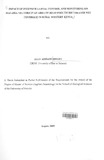| dc.contributor.author | Omary, Ally A | |
| dc.date.accessioned | 2013-03-18T07:43:15Z | |
| dc.date.issued | 2009 | |
| dc.identifier.citation | Master of Science (Applied Parasitology) | en |
| dc.identifier.uri | http://erepository.uonbi.ac.ke:8080/xmlui/handle/123456789/14369 | |
| dc.description.abstract | Integrated control of vectors of human malaria in sub-Saharan Africa relies on strategic
targeting of mosquito vectors. An anti-larval control study was implemented in an area of
high insecticide treated bed net (ITN) coverage in rural western Kenya with perennial
malaria transmission. The goal was to determine whether larval control would provide
added benefit to ITNs in reducing malaria transmission. Larval control using Bti was
implemented in a 2 x 2 km2 zone in Asembo, western Kenya. A neighboring 2 x 2 km2
zone was identified as non-intervention zone. Larviciding and monitoring was done once
weekly in all potential habitats within the intervention zone. Larval and adult An.
gambiae populations were sampled fortnightly in both zones for a period of 7 months.
An. gambiae larval density in the intervention zone was reduced by 79% for all instars
and 97% for the late instars (L3, L4 and pupae). Fewer female Anopheles mosquitoes
(39.5%) were observed in the intervention zone after controlling for household ownership
of bednets (Relative ratio (RR) = 0.605, p<O.OOl).However, in limited pre- and postintervention
collections, data suggest a pre-existing trend in lower mosquito numbers in
the intervention zone and therefore, new study is needed to determine whether reduced
densities were due to pre-existing differences in the two zones. This study concludes that
intensive larviciding and ITNs use can further reduce human exposure to malaria vectors
in endemic rural settings. | en |
| dc.description.sponsorship | University of Nairobi | en |
| dc.language.iso | en | en |
| dc.publisher | University of Nairobi | en |
| dc.subject | Larval control | en |
| dc.subject | Monitoring | en |
| dc.subject | Malaria vectors | en |
| dc.subject | Insecticide | en |
| dc.subject | Treated net | en |
| dc.subject | Rural Western Kenya | en |
| dc.title | Impact of intensive larval control and monitoring on malaria vectors in an area of high insecticide treated net coverage in rural Western Kenya | en |
| dc.type | Thesis | en |
| local.publisher | School of Biological Sciences | en |

